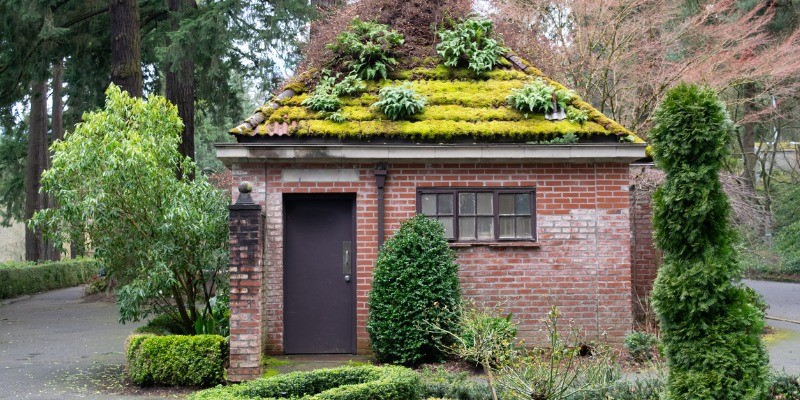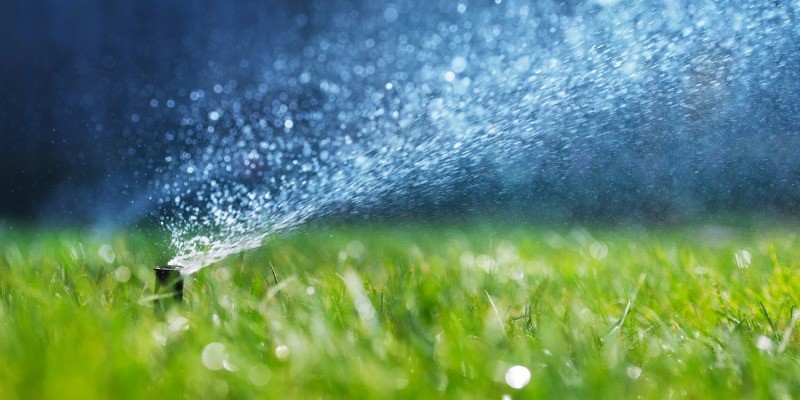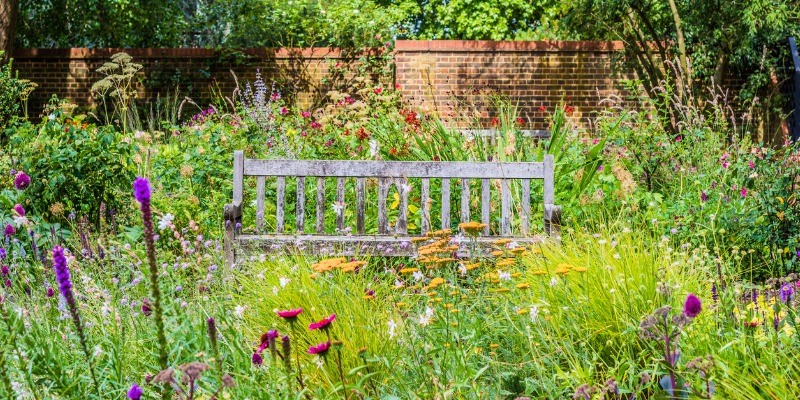
The home building industry has embraced green methods in leaps and bounds. Although every aspect of the home has been addressed, many homeowners overlook their outdoor space. While the interior of your home and the materials used seem a logical place to start, the exterior of your home can also benefit from eco-friendly yard options.
From irrigation systems to landscape design and water-saving tips to green walls and pollination, your outdoor space offers dozens of innovative, eco-friendly methods to discover. Here we explore the beautiful and functional aspects of your private outdoor spaces and how you can create an eco-friendly yard.
The Benefits of Green Roofs and Walls
A green roof uses the beauty of nature to extend the efficiency of your roofing system. It combines effective waterproofing and drainage in hand with live plants to help regulate your home’s temperature. Every element is designed to be lightweight and water repellent including a drainage system and filter cloths to encourage the healthy growth of a well-chosen assortment of plantings. As a result, you create a little oasis on your roof, which helps to reduce the effects of the urban heat island.
Benefits of a Green Roof
The benefits of a green roof are:
- Regulating your home’s temperature
- Reducing stormwater runoff
- Reducing the urban heat island effect
- Longer roof life
- Energy savings on heating and cooling
- Potential for urban food production
- Increasing urban biodiversity
They also offer the psychological benefits of green space to boot.
Types of Green Roofs
There are three types of green roofs:
- Extensive Green Roofs: These roofs provide environmental solutions and can be used for flat roof buildings and apartment buildings. They are also perfect for low-sloped residential roofs and can be retrofitted to suit your needs. They are incredibly low maintenance using ground cover plants such as grasses and succulents. The second summer following installation, your green roof becomes even easier to manage as it depends strictly on rain to survive. It does require an annual weeding to remove anything that could interfere with its efficiency.
- Intensive Green Roofs: This roof is more like a rooftop garden. You’ll see higher growth that can reach up to a foot, which allows for innovative landscaping design. You can introduce more diverse plants and even some trees as long as their roots aren’t too invasive. These roofs are used for outdoor living spaces and often include walkways, lighting, and furniture. Some become playgrounds and many families will plant vegetable gardens.
- Semi-intensive Green Roofs: These roofs combine the best of both worlds combining extensive and intensive systems. People enjoy having the environmental benefits of the extensive green roof while also customizing the intensive elements to suit their budgets.
You can choose to add more diversity with a semi-intensive green roof, but each option allows you to customize features to suit your budget.
Green Roof Statistics
Some interesting statistics about green roofs:
- Energy Use and Economy: Studies show that a typical 2 to 3 story building can save from 15 to 25 percent in cooling energy costs.
- Water Management: You can catch 40 to 60 percent of stormwater with a green roof that greatly reduces the amount of water flowing into city sewers.
- Urban Heat: If 60 percent of Toronto’s downtown surfaces had green roofs, it would cool the city by 0.1 to 0.8°C. In fact, just two green roofs in peak summertime reduce roof heat by 35°F and the heat flow in summer by 70 to 90 percent compared with a basic roof.
How Do Green Walls Help?
Green walls offer the same benefits as green roofs, with a few additions:
- Green walls can reduce temperatures by up to 10 degree Celsius
- They also reduce urban noise
- The shade of green walls can reduce energy costs by 23 percent
They also add a lovely addition to any outdoor space, ideal for added privacy, interesting focal points, and excellent ways to create different areas in your yard.
Eco-friendly Irrigation
Irrigation systems not only make maintaining your property easier but also help manage water usage. Eco-friendly irrigation is the best way to save water and keep your garden looking its best. Drip irrigation water usage also known as plant drip systems, keeps your lawn green and lush. Not only do you inspire neighbour envy, but also have a clear conscious knowing you’re doing everything possible to conserve water.
Drip irrigation systems are easy to install, reduce runoff, and deliver water and/or nutrients to your garden. By introducing water at the root, they are far more efficient in promoting healthy lawns and gardens. In the most advanced systems, you can actually set the watering levels, so each type of plant gets the exact amount of water required to thrive. Water moisture levels in the soil are regulated so water is conserved and used only when necessary.
Features of Eco-Friendly Irrigation
The features available for drip irrigation systems include:
- Irrigation Emitters: Choose a system with pressure-compensating emitters as each plant receives the right amount of water during the watering cycle.
- Self-Flushing: Filters in your system work to keep out debris. However, this additional feature flushes out dirt accumulation not caught by the filters to improve efficiency.
- Built-in Check Valves: This is a must as it helps stop “back-siphoning.” This occurs when a vacuum develops due to changes in water pressure. This forces the water in the opposite direction of where you want it to go.
These features provide the most efficient irrigation systems.
Consider Usage
There are different uses to consider for your irrigation system other than lawn watering including:
- Micro-Sprayers in Garden Beds: These are ideal throughout your garden and can be covered up using mulch to blend in with your landscape.
- Bubblers in Urns and Planters: These are great if you have a lot of potted plants on your deck, as they are installed in the urns and the lines are hidden beneath your deck or patio.
- Emitters for Hedges and Shrubs: Your privacy hedges and decorative shrubs need proper watering which can easily be achieved with emitters running below.
These features take the entire garden into consideration.
Benefits of Eco-Friendly Irrigation Systems
There are many benefits to installing an eco-friendly irrigation system including:
- Conserves water which in turn saves money on water bills
- Increases home value
- Improves curb appeal with healthy green lawns
- Even watering for healthier plants
- Low maintenance garden and lawn care
- Timed to water at perfect times of day
- Reduces plant disease as well as fungi from overwatering
- Easy use if you travel often
It really is a homeowner’s dream promoting healthy lawns, low maintenance care, and eco-friendly water conservation for cost savings.
Water-Saving Tips
Irrigation is not the only way to save water for your property. You can also use water conservation landscape designs to create an eco-friendlier garden. Some common practices of water conservation landscaping include:
- Planning and designing your landscaping based on your regional climate and microclimate.
- Grouping plants with similar watering needs in the same area of your property.
- Selecting grass species that require less water, or choosing lawn alternatives.
- Using healthier soil to improve absorbency and water conservation.
- Introducing drip irrigation systems.
- Using mulch to reduce water evaporation and keep roots cool while reducing weeds that can drink up more water.
- Proper maintenance to reduce weeds, keep gardens fertilized, and pests under control.
- Planting rain gardens to capture and clean groundwater with colourful perennials and shrubs to create pretty, yet functional flower beds.
- Capturing gray water in rain barrels or cisterns to pump water back into the garden to reduce runoff.
Your landscaping should be designed to conserve water while improving curb appeal and creating a calming green space for you to enjoy.
Landscape Design
The tips we’ve provided above are not only ideal to save water, but also to create eco-friendly landscaping. Eco-friendly landscape design is aesthetically pleasing, but also uses the beauty of your area’s natural plants to create very versatile yet functional spaces. Some innovative eco-friendly landscaping ideas include:
Use Permeable Surfaces
Permeable surfaces prevent erosion while also adding texture and colour to your landscaping design. From pathways to unique areas such as designated patios and courtyards, permeable surfaces are eco-friendly because they decrease runoff and help capture rainwater in your gardens. They soften the appearance of your hard surfaces for a more calming effect.
Decomposed Granite
Also known as DG, this material is taking garden design by storm, providing many uses from mulch to reduce weeds to creating softer, natural-looking paths or driveways. Like permeable surfaces, it helps break up traditional hard surfaces and lawns, adding texture.
Pea Gravel
This old idea is finding new life in modern gardens where colour and texture are always welcome. The natural shape and tones of these small, smooth stones are ideal to create a different kind of mulch. They also have a pleasant crunch underfoot to create softer, prettier paths.
Ribbon Driveways
Another old-school design, this adds more grass to your driveway with a ribbon of lawn positioned between the natural gap of car tires. It reduces the use of paving materials while adding an interesting pattern. It’s also far more affordable than paving, cement, and interlock alone.
Artificial Grass
This might seem the opposite of eco-friendly design, but lawns drink up way more water than anything in your garden. Artificial grass provides the green look you love without the negatives of grass such as ongoing maintenance and water-guzzling.
Wildflower Meadow
Nothing is prettier than a meadow of wildflowers ideal to take up large spaces of your garden. It reduces the need for grass, adds a year-round focal point, and provides additional soft surfaces. It also attracts bees. If you prefer you can use herbs for a more neutral green palette. Your herbs provide a practical solution, ideal for the gourmet while offering a low maintenance garden with budget-friendly perennial options that also flower.
Native Plants and Heirlooms
As mentioned, native plants respond better to gardens as they are in their ideal environment. They look good and tend to use less water as they are designed to thrive in the exact environment you are providing. Heirloom seeds are another trend that introduces flowers and plants passed on for generations. They are hardy, provide lovely aromas to your outdoor space, and even come in veggie species like tomatoes.
Pollinating Plants
Give the bees and other pollinators in your neighbourhood a boost with a pollinator’s garden. This trend provides shelter to an assortment of pollinators including bats, bees, butterflies, beetles, and even small mammals that help contribute to the important pollination cycle.
The Benefits of Pollination
There are many benefits to pollination including:
- Contributing to food production for fruits, vegetables, and nuts
- Providing the world’s oils, fibers, and raw materials
- Preventing soil erosion
- Increasing carbon sequestration
Your garden can help support the local wildlife that contributes to this important cycle.
How to Produce A Pollinator Garden
You can create a pollination garden using the best pollinator plants including:
- Eastern redbud
- Wild lupine
- Ninebark
- Garden phlox
- Pincushion flower
- Lamb’s ear
- Butterfly weed
- False sunflower
- Prairie blazing star
- Foxglove beadtongue
- Carpet rose
- Wiegela
- Fall anemone
- Russian sage
This varied assortment is stunning, allowing you to create eye-pleasing customized landscape designs ideal for your personal taste and budget.
How to Create a Pollinator Garden
Tips for a pollinating garden include:
- Use a variety to attract more pollinators
- Use plants with varied blooming times throughout the year
- Choose native species
- Leave plants in place to offer winter shelter
- Add features such as birdbaths and bee houses
- Avoid using pesticides and herbicides of any kind
- Use containers in small spaces to optimize the number of plants on your property
As you can see, the benefits of eco-friendly yards provide not only improved aesthetics but also green options to converse water and reduce energy consumption.
Need a Pro to Help With Your Eco-Friendly Yard?
From a green roof to a pollinator garden at Lawrence Park, we take pride in our eco-friendly efforts. We will keep your mind at ease with eco-friendly landscaping while providing you with a beautiful landscape. Contact our team today.

